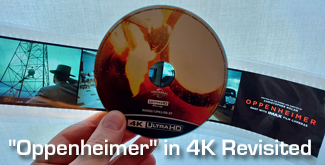"Oppenheimer" in 4K Revisited | Read more at in70mm.com The 70mm Newsletter |
| Written by: Jonathan Kleefield, M.D., Boston, USA | Date: 25.02.2024 |
 70mm IMAX Film of 4K BluRay? "... both formats gave amazing spatial resolution, with the 65mm giving the IMAX system “stiff competition” in terms of the finest facial details ..." 70mm IMAX Film of 4K BluRay? "... both formats gave amazing spatial resolution, with the 65mm giving the IMAX system “stiff competition” in terms of the finest facial details ..."Today, using a bitter cold day as an excuse to stay inside, I finally broke open the package that contained my 4K UHD copy of “Oppenheimer.” With considerable anticipation, I loaded the disc into my Oppo 203 4K video player, which fed its signal to my 83” Sony 90J OLED screen. This TV has “IMAX enhanced” screen viewing settings, which I employed for this presentation. The sound was provided by my Denon 7.1 channel receiver running a suite of Klipsch speakers, and was encoded, as seems most common these days, via DTS. I have mildly boosted the center channel to try to improve dialog clarity, but wanting to be sure I captured the dialog completely, employed subtitles. I can only say that viewing this film a second time was a revelation, in terms of better understanding the plot, but Mr. Nolan’s and Jennifer Lame’s constant transposition of material, with an editing style that seemed more brisk than I appreciated the first time, would make it hard for someone unfamiliar with this story to follow it with any comprehension of the details. I was able to do so because I had previously read many treatises on the atomic bomb development, including “American Prometheus,” the book that Mr. Nolan used to write the screenplay. So many characters fill the film that the unprepared observer would have almost no chance of figuring out “who was who.” For someone as prepared as I was, this time I more thoroughly appreciated the intricate construction of the film itself. Once again, I was very impressed with the performances, particularly Cillian Murphy, who should be a shoo-in for Best Actor at the Academy Awards. However, Robert Downey Jr.’s portrayal of Lewis Strauss was also brilliant, with both actors capturing the nuances of their complex personalities. • Go to "Oppenheimer" Reviews • Go to "Oppenheimer" filmed in 65mm with IMAX cameras What now was apparent, and expected by me, was the vastly improved image quality my home system provided me, even compared with the IMAX 15/70 presentation I viewed in August 2023. [At the Providence Place Cinemas 16 and IMAX, Rhode Island, USA, ed] While the IMAX images utilized the full screen, there was only minor letterboxing when the 65mm segments were displayed. They were hardly noticeable. At least on my home viewing system, both formats gave amazing spatial resolution, with the 65mm giving the IMAX system “stiff competition” in terms of the finest facial details, particularly when viewing the aging makeup employed for Oppenheimer. There were very slight, but almost indistinguishable differences between the two for image sharpness and contrast. Speaking of the latter, I am now fully convinced that the self emissive display of an OLED TV trounces what can be shown on a cinema screen. The darker scenes I complained about when viewing the film in Providence now fully developed on my home system, again representing what “true black” can do for image quality optimization. The black and white cinematography was by turns luminous, and in certain scenes, photographed with deliberately excessive contrast to emphasize particularly dramatic moments. Making my own sound adjustments, and particularly throttling down the music levels put it in the aesthetic position I feel is appropriate for film scoring, namely, as a dramatic support for action, and not something that drowns out dialog. That, of course, is only my opinion. We know that Mr. Nolan sometimes states that dialog clarity is not always important to him, but I would ask him “if that is so, why include it in the first place?” As I had observed the first time, I was not overawed by the “practical effect” of the Trinity bomb explosion- using the real footage would have been just, or more effective. The flashing lights and streaks to try to give the viewer an impression of the quantum world made no better impression on me than it did the first time. I did like the separation of the Trinity bomb flash from the later sonic blast, although I think the time difference was excessive, given the distance the observers were placed relative to the explosion, and knowing the speed of sound. This is a truly minor quibble, and perhaps the time was lengthened for dramatic effect. In summary, this wonderful film deserves more than one viewing. It is a masterpiece, but its complexity in plot exposition and material presented can be very difficult for the unprepared viewer to comprehend what is really being depicted, and therefore appreciate the nuances of the story. I urge cinephiles to buy the 4K UHD disc if you have the proper means to view it. I will use it as a means to demonstrate the power of the current home cinema system. | More in 70mm reading: "Oppenheimer" filmed in 65mm with IMAX cameras "Oppenheimer" Reviews in70mm.com's page about IMAX & Omnimax in70mm.com's Library Presented on the big screen in 7OMM Peripheral Vision, Scopes, Dimensions and Panoramas |
 • Go to "Oppenheimer" in 4K Revisited | |
| Go: back - top - back issues - news index Updated 25-02-24 |
